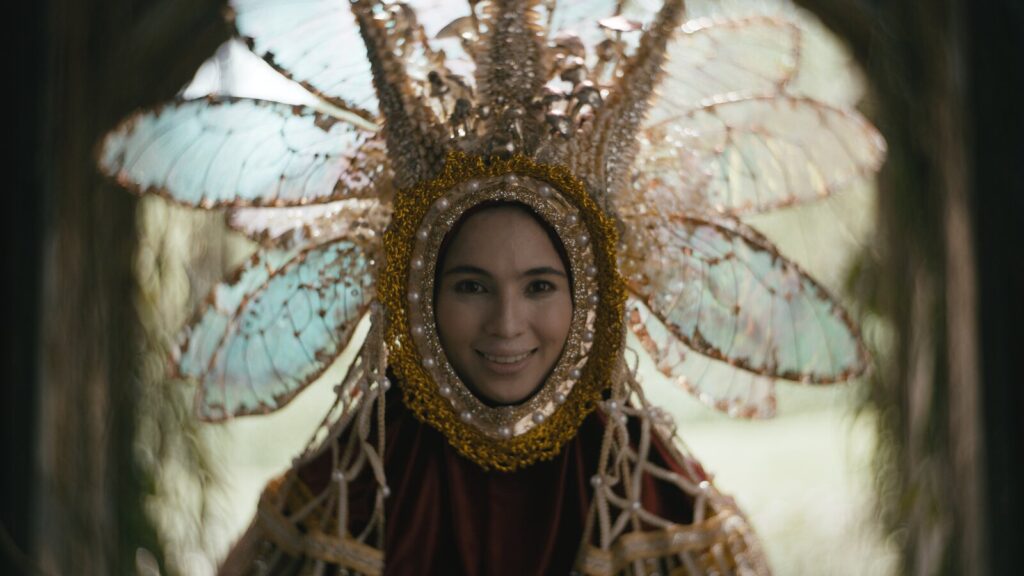Streaks of blood, an elegantly gilded forest fairy, cathedral glass windows and regurgitated saliva-drenched crows.
Without a doubt, Filipino director Kenneth Dagatan’s folk horror In My Mother’s Skin is aesthetically pleasing. The international coproduction between the Philippines, Singapore and Taiwan premiered at this year’s Sundance Film Festival as part of the Midnight Section and became an instant hit among Western critics.

Heavily alluding to Guillermo del Torro’s iconic Pan’s Labyrinth (2006) and Alejandro Amenábar’s terrific The Others (2001) — with a whisper of Alfred Hitchcock’s The Birds (1963 ) — Dagatan’s sophomore film centers on a young heroine, Tala (a brilliant Felicity Kyle Napuli), at the tail-end of World War-II Philippines.
Dagatan isolates the viewers in an exquisite colonial mansion surrounded by a mystical forest, far removed from the echoes of the war and Japanese brutality. Cooped up in the manor with Tala is her little brother, Bayani (James Estrella), their mysteriously ill mom (Beauty Gonzales) and the nanny (Angeli Bayani).
I had to see it twice, as the first viewing experience was so poorly projected on a wide screen that it felt like I was watching blindly due to the film’s perplexing absence of light. But streaming it on my phone on Prime Video revealed the film’s striking production design and cinematography — still largely low-lit, but the details are thankfully discernible.
Anxious child
The child Tala is the heart of this fanciful fantasy-horror. An extremely anxious child who easily falls into pits of hopelessness and impatience, she is always worried — about their diminishing food supply, the Japanese soldiers, her sick mother and is convinced that her father (Arnold Reyes), who is away for an indefinite period of time, is dead.
Dagatan latches on to the child’s disquietude to propel the narrative. And if you expect Tala’s problems to resolve one by one, you will be disappointed, because, well, this is a horror movie. Things are just bound to get worse.

Driven by an impulse to solve her predicaments, Tala frantically goes into the forest for anything to help her and her family. She discovers a hut, and there she steals a yema candy and enjoys this rare wartime extravagance. But the sweet is a devil’s bait wrapped in red, instantly transporting her to a plane of reality where a diwata (Jasmine Curtis-Smith), looking like the Catholic Church’s Mother Mary, becomes Tala’s corporeal hope.
Dagatan’s style is controlled. Cold and calculated. He utilizes darkness and an exquisite sound design of cicadas, floor-skitters and moody strings for eerie foreboding.
But, really, it’s all style rather than substance.
Each sequence feels like a standalone piece and not part of a bigger picture, frequently ending with a monster show — only to quickly cut to black, with the next scene pretending that nothing sinister had just happened. This leaves you repeatedly shortchanged. The sensation feels like watching a series of paintings from the same artist with the same gory visuals, but disconnected from one another.
Disjointed storytelling
The problem lies with Dagatan’s disjointed storytelling and his indecision to focus on a singular, powerful threat. Is it the diwata with her vague motive? Is it the red-eyed flesh-eating mother playing hide and seek? Is it the invisible Japanese forces? Is it the war? Is it greed? Is it Tala’s lack of faith? Is it the inaction from a deity that they pray to? Is it all of the above? All of these elements come together in a highly stylized but convoluted, emotionless fare.

The characters also do not share convincing relationships with each other. The worst possible domestic terror is seeing your own mother become nothing but a shell of her former self. Worse, a nurturer turned predator. But the kids merely comment that something is “not right with her.” None of them is seriously terrified of the mother’s complete transformation from sickly to a comically deranged woman peeking from underneath her kid’s bed and munching on a pet dog (which you didn’t know existed in the first place). Everyone dismisses her monster era as if it were merely a disgusting curiosity.
Meanwhile, the nanny Amor is barely nannying. Bayani’s most prominent scene is noisily rummaging through the matriarch’s vanity table for gold bars while the monster-mom is asleep.
In My Mother’s Skin doesn’t cut through the psyche and the heart. It barely scrapes the skin, offering no chills or emotional connection.
Except for Napuli’s luminous performance, the film is mainly all for show, borrowing inspirations from a library of the filmmaker’s favorite horror fantasies. It’s a sophisticated visual feast boasting technical craft, a buffet of sights and sounds — but doesn’t give you any experience to chew on.
1.5 out of 5 stars
Premiered 12 October on Prime Video
